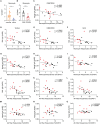Sex-biased immunogenicity of a mucosal subunit vaccine against SARS-CoV-2 in mice
- PMID: 38835757
- PMCID: PMC11148259
- DOI: 10.3389/fimmu.2024.1386243
Sex-biased immunogenicity of a mucosal subunit vaccine against SARS-CoV-2 in mice
Abstract
Introduction: Current vaccines against COVID-19 administered via parenteral route have limited ability to induce mucosal immunity. There is a need for an effective mucosal vaccine to combat SARS-CoV-2 virus replication in the respiratory mucosa. Moreover, sex differences are known to affect systemic antibody responses against vaccines. However, their role in mucosal cellular responses against a vaccine remains unclear and is underappreciated.
Methods: We evaluated the mucosal immunogenicity of a booster vaccine regimen that is recombinant protein-based and administered intranasally in mice to explore sex differences in mucosal humoral and cellular responses.
Results: Our results showed that vaccinated mice elicited strong systemic antibody (Ab), nasal, and bronchiole alveolar lavage (BAL) IgA responses, and local T cell immune responses in the lung in a sex-biased manner irrespective of mouse genetic background. Monocytes, alveolar macrophages, and CD103+ resident dendritic cells (DCs) in the lungs are correlated with robust mucosal Ab and T cell responses induced by the mucosal vaccine.
Discussion: Our findings provide novel insights into optimizing next-generation booster vaccines against SARS-CoV-2 by inducing spike-specific lung T cell responses, as well as optimizing mucosal immunity for other respiratory infections, and a rationale for considering sex differences in future vaccine research and vaccination practice.
Keywords: SARS-CoV-2; and sex differences; innate immunity; lung tissue-resident T cells; mucosal vaccine.
Copyright © 2024 Li, Hsu, Howe, Hoang, Xia, Berzofsky and Sui.
Conflict of interest statement
The authors declare that the research was conducted in the absence of any commercial or financial relationships that could be construed as a potential conflict of interest.
Figures







Similar articles
-
An Intranasal OMV-Based Vaccine Induces High Mucosal and Systemic Protecting Immunity Against a SARS-CoV-2 Infection.Front Immunol. 2021 Dec 17;12:781280. doi: 10.3389/fimmu.2021.781280. eCollection 2021. Front Immunol. 2021. PMID: 34987509 Free PMC article.
-
Intranasal administration of unadjuvanted SARS-CoV-2 spike antigen boosts antigen-specific immune responses induced by parenteral protein subunit vaccine prime in mice and hamsters.Eur J Immunol. 2024 Jun;54(6):e2350620. doi: 10.1002/eji.202350620. Epub 2024 Apr 1. Eur J Immunol. 2024. PMID: 38561974
-
Peritoneal Administration of a Subunit Vaccine Encapsulated in a Nanodelivery System Not Only Augments Systemic Responses against SARS-CoV-2 but Also Stimulates Responses in the Respiratory Tract.Viruses. 2021 Nov 2;13(11):2202. doi: 10.3390/v13112202. Viruses. 2021. PMID: 34835008 Free PMC article.
-
Severe acute respiratory syndrome-coronavirus-2 spike (S) protein based vaccine candidates: State of the art and future prospects.Rev Med Virol. 2021 May;31(3):e2183. doi: 10.1002/rmv.2183. Epub 2020 Oct 15. Rev Med Virol. 2021. PMID: 33594794 Free PMC article. Review.
-
Intranasal vaccines for SARS-CoV-2: From challenges to potential in COVID-19 management.Drug Discov Today. 2021 Nov;26(11):2619-2636. doi: 10.1016/j.drudis.2021.07.021. Epub 2021 Jul 29. Drug Discov Today. 2021. PMID: 34332100 Free PMC article. Review.
Cited by
-
Sexual dimorphism-driven differences are overcome in a preclinical vaccine model against Trypanosoma cruzi.Front Immunol. 2025 Jun 26;16:1526573. doi: 10.3389/fimmu.2025.1526573. eCollection 2025. Front Immunol. 2025. PMID: 40642088 Free PMC article.
-
Adjuvanted subunit intranasal vaccine reduces SARS-CoV-2 onward transmission in hamsters.Front Immunol. 2025 Feb 7;16:1514845. doi: 10.3389/fimmu.2025.1514845. eCollection 2025. Front Immunol. 2025. PMID: 39981227 Free PMC article.
References
-
- Gunale B, Kapse D, Kar S, Bavdekar A, Kohli S, Lalwani S, et al. . Safety and immunogenicity of Sars-Cov-2 recombinant spike protein vaccine in children and adolescents in India: A phase 2–3 randomized clinical trial. JAMA Pediatr. (2023) 177:911–20. doi: 10.1001/jamapediatrics.2023.2552 - DOI - PMC - PubMed
MeSH terms
Substances
LinkOut - more resources
Full Text Sources
Medical
Research Materials
Miscellaneous

